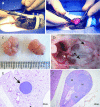A mouse surgical model for metastatic ovarian granulosa cell tumor
- PMID: 20034430
- PMCID: PMC2798836
A mouse surgical model for metastatic ovarian granulosa cell tumor
Abstract
We recently described a genetically engineered mouse model that develops ovarian granulosa cell tumors (GCTs) that mimic many aspects of the advanced human disease, including distant dissemination. However, because the primary tumors killed their hosts before metastases were able to form, the use of these mice to study metastatic disease required the development of a simple, reliable, and humane surgical protocol for the excision of large GCTs from debilitated mice. Here we describe a protocol involving multimodal anesthesia, tumor removal through ventral midline celiotomy and perioperative fluid therapy, and analgesia that led to the postoperative survival of more than 90% of mice, despite the removal of tumors representing as much as 10% of the animal's body weight. Intraabdominal recurrence of the GCT did not occur in surviving animals, but most developed pulmonary or adrenal metastases (or both) by 12 wk after surgery. We propose that this mouse model of metastatic GCT will serve as a useful preclinical model for the development of novel treatment modalities and diagnostic techniques. Furthermore, our results delineate anesthetic and surgical principles for the removal of large abdominal tumors from mice that will be applicable to other models of human cancers.
Figures


Similar articles
-
Synergistic effects of Pten loss and WNT/CTNNB1 signaling pathway activation in ovarian granulosa cell tumor development and progression.Carcinogenesis. 2008 Nov;29(11):2062-72. doi: 10.1093/carcin/bgn186. Epub 2008 Aug 6. Carcinogenesis. 2008. PMID: 18687666 Free PMC article.
-
Juvenile granulosa cell tumor.Clin Imaging. 2003 Jul-Aug;27(4):221-4. doi: 10.1016/s0899-7071(02)00586-7. Clin Imaging. 2003. PMID: 12823914 Review.
-
Comparison of proliferation indices in primary adult-type granulosa cell tumors of the ovary and their corresponding metastases: an analysis of 14 cases.Int J Gynecol Pathol. 2009 Sep;28(5):423-31. doi: 10.1097/PGP.0b013e31819d8153. Int J Gynecol Pathol. 2009. PMID: 19696611
-
Recurrence of granulosa cell tumor 25 years after initial diagnosis. Report of a case and review of the literature.Eur J Gynaecol Oncol. 2008;29(1):86-8. Eur J Gynaecol Oncol. 2008. PMID: 18386473 Review.
-
Immunohistochemical phenotype of ovarian granulosa cell tumors: absence of epithelial membrane antigen has diagnostic value.Hum Pathol. 1994 Jan;25(1):60-6. doi: 10.1016/0046-8177(94)90172-4. Hum Pathol. 1994. PMID: 8314261
Cited by
-
First in-mouse development and application of a surgically relevant xenograft model of ovarian carcinoma.PLoS One. 2014 Mar 4;9(3):e89527. doi: 10.1371/journal.pone.0089527. eCollection 2014. PLoS One. 2014. PMID: 24594904 Free PMC article.
-
Anti-VEGFA Therapy Reduces Tumor Growth and Extends Survival in a Murine Model of Ovarian Granulosa Cell Tumor.Transl Oncol. 2013 Jun 1;6(3):226-33. doi: 10.1593/tlo.13136. Print 2013 Jun. Transl Oncol. 2013. PMID: 23730402 Free PMC article.
References
-
- Canadian Council on Animal Care 1984. Chapter XIX, laboratory mice. : Guide to the care and use of experimental animals. Ottawa (Canada): Canadian Council on Animal Care
-
- Cantwell SL. 2001. Ferret, rabit, and rodent anesthesia. Vet Clin North Am Exot Anim Pract 4:169–191 - PubMed
-
- East N, Alobaid A, Goffin F, Ouallouche K, Gauthier P. 2005. Granulosa cell tumor: a recurrence 40 years after initial diagnosis. J Obstet Gynaecol Can 27:363–364 - PubMed
-
- Flecknell PA, Richardson CA, Popovic A. 2007. Laboratory animals, p 765–784. In: Tranquilli WJ, Thurmon JC, Grimm KA. Lumb and Jones' veterinary anesthesia and analgesia. Ames (IA): Blackwell Publishing Professional
Publication types
MeSH terms
Grants and funding
LinkOut - more resources
Full Text Sources
Medical
